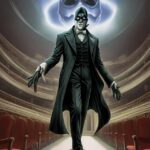In the enchanting world of wizards and magic, J.K. Rowling weaves yet another captivating tale that has captured the imaginations of millions: “Harry Potter and the Half-Blood Prince.” As the sixth installment in the iconic Harry Potter series, this book delves deep into the darkest corners of the wizarding realm, revealing secrets, alliances, and a gripping plot that will leave readers spellbound.
Join us as we journey back to Hogwarts School of Witchcraft and Wizardry, where an unexpected ally emerges, ancient prophecies are unveiled, and the battle between good and evil intensifies. Prepare to be enthralled as we unveil the hidden depths of this enchanting tale, satisfying your curiosity and keeping you entranced until the very last page. Are you ready to immerse yourself in the sixth chapter of Harry Potter’s legendary adventure? Read on to discover the riveting twists and turns that await in “Harry Potter and the Half-Blood Prince.”
Harry Potter and the Half-Blood Prince: Full Book Summary
Once upon a time, in a magical world filled with wizards, witches, and fantastical creatures, there lived a young boy named Harry Potter. Harry was special – he was a wizard, just like his parents were before they tragically passed away. Harry had already been through many adventures and faced numerous challenges at the Hogwarts School of Witchcraft and Wizardry, where he learned magic and made lifelong friends.
In the sixth installment of his magical journey, “Harry Potter and the Half-Blood Prince,” Harry was about to embark on his most important year yet. It was his sixth year at Hogwarts, and the wizarding world was in turmoil. Lord Voldemort, the most feared and powerful dark wizard, was growing stronger by the day, and his minions were spreading chaos and fear everywhere.
Harry’s summer before returning to Hogwarts was anything but ordinary. He learned that Dumbledore, the wise and kind headmaster of Hogwarts, had personally set out to collect an old Hogwarts professor named Horace Slughorn. Dumbledore believed that Slughorn possessed crucial information that could help defeat Voldemort, and so it was up to Harry to persuade Slughorn to come out of hiding.
When Harry arrived at Hogwarts, he noticed a significant change. Students were on edge, knowing that danger lurked outside the walls. Dumbledore had tasked Professor Snape to teach Defense Against the Dark Arts, a position coveted by many. This appointment raised questions and uncertainty among the students, including Harry and his friends, Ron and Hermione.
In their sixth year, Harry and his friends faced the challenges of growing up, studying for their important exams, and dealing with complicated emotions. Ron and Hermione’s relationship grew more complex, causing tension between them. Harry, on the other hand, had developed feelings for Ginny Weasley, Ron’s younger sister. However, he tried to suppress these feelings, knowing that their friendship and the looming threat from Voldemort were more important.
During their classes, Harry and his fellow students learned about many fascinating aspects of magic, including the powerful spell called Sectumsempra, discovered by the mysterious Half-Blood Prince. This Prince left behind an old potions textbook that Harry found and used throughout the year, unknowingly changing the course of his journey.
As the year progressed, Harry found moments of solace and instruction with Dumbledore, who began to share memories from his past. Through these memories, Harry discovered more about Voldemort’s rise to power and the horcruxes – objects in which Voldemort concealed parts of his soul, making him nearly immortal. Destroying these horcruxes would be vital to defeating the dark wizard once and for all.
Meanwhile, Harry’s friendship with Dumbledore grew stronger as they journeyed together, seeking answers and uncovering secrets. Dumbledore became a mentor to Harry, guiding him in his mission to discover the truth about the Half-Blood Prince and uncover Voldemort’s weaknesses.
However, not everything was as it seemed. Draco Malfoy, one of Harry’s rivals, had taken on a mysterious and dangerous task assigned to him by Voldemort. Harry suspected that Malfoy was up to no good and spent a great deal of time trying to discover his true intentions. This created further tension between him and his friends, who were concerned for his safety.
As the year drew to a close, Harry was faced with a heart-wrenching tragedy. Dumbledore, his guide and protector, was brutally murdered by Professor Snape, leaving Harry feeling lost and alone. The whole wizarding world mourned the loss of their beloved headmaster, and Harry realized the immense responsibility he now carried.
The book ended with Harry vowing to find and destroy the remaining horcruxes, continuing the quest Dumbledore had started. He knew that this journey would be perilous, but with the unwavering support of his friends, the memory of Dumbledore’s wisdom, and the love and strength within him, Harry was determined to face whatever challenges lay ahead.
“Harry Potter and the Half-Blood Prince” was a tale of personal growth, friendship, and sacrifices made in the fight against darkness. It showcased the power of love, loyalty, and the importance of standing up for what is right. Harry’s journey resonated deeply with readers of all ages, reminding us that even in the darkest times, hope and bravery can shine through.
Harry Potter and the Half-Blood Prince: Key Themes
“Harry Potter and the Half-Blood Prince,” written by J.K. Rowling, takes readers deeper into the wizarding world as Harry prepares for his sixth year at Hogwarts School of Witchcraft and Wizardry. This book marks a turning point in the series, setting the stage for the final battle between Harry and the dark wizard, Lord Voldemort. Here are three key themes explored in this captivating installment:
1. The Quest for Knowledge and Power:
Throughout the book, various characters are motivated by the pursuit of knowledge and power. Harry strives to uncover the hidden truths about Voldemort’s past, searching for any information that could help defeat him. Albus Dumbledore, the headmaster of Hogwarts, reveals fragments of the dark wizard’s history to Harry, sharing his knowledge as he prepares him for his eventual role as the Chosen One. Severus Snape, another crucial character, also seeks knowledge in his relentless quest for power. The theme of knowledge and power intertwines as characters uncover secrets, manipulate information, and make moral choices that impact the wizarding world.
2. Love and Sacrifice:
Love and sacrifice play a significant part in the story. Harry grapples with his growing feelings for Ginny Weasley, Ron Weasley’s younger sister, while Ron begins a complicated relationship with Lavender Brown. These romantic relationships demonstrate the complexities and sacrifices that love demands. On a more profound level, there is the selfless love and sacrifice of Dumbledore, who takes Harry under his wing and guides him into potentially dangerous situations to prepare him for the fight against Voldemort. The theme of love is portrayed not only in romantic connections but also in the loyalty, friendship, and sacrifices made for others.
3. The Intricacy of Good and Evil:
Another key theme explored in the “Half-Blood Prince” is the intricacy of good and evil. The book delves deeper into Voldemort’s character, showcasing his origins and motivations. It offers a glimpse into his past, revealing the choices and experiences that shaped him into the villainous figure he has become. Rowling highlights the complexities of human nature, demonstrating that even characters who are considered “good” can possess flaws or make morally questionable decisions. Snape, a character whose true allegiance remains enigmatic, blurs the lines between good and evil, leaving readers questioning his motivations until the very end. This theme emphasizes that good and evil are not absolute, but rather a spectrum influenced by personal choices and circumstances.
In “Harry Potter and the Half-Blood Prince,” J.K. Rowling weaves together these key themes of knowledge and power, love and sacrifice, and the intricacy of good and evil. As the series builds towards its climax, these themes deepen the complexity of the characters and illuminate the moral dilemmas they face in their battle against the dark forces threatening the wizarding world.
Harry Potter and the Half-Blood Prince: Characters
Harry Potter
The protagonist of the story, Harry is a young wizard attending his sixth year at Hogwarts School of Witchcraft and Wizardry. He has untidy jet-black hair, round glasses, and a lightning-shaped scar on his forehead. Known for his bravery and loyalty, Harry is determined to uncover the truth about Lord Voldemort’s past and his plans for the wizarding world.

Ron Weasley
Harry’s best friend and a loyal companion, Ron is a tall and lanky wizard with fiery red hair and freckles. He comes from a large and loving family, with a knack for making sarcastic comments and a deep love for food. Throughout the story, Ron struggles with his feelings for Hermione Granger and faces challenges that test his courage.
Hermione Granger
The brains of the trio, Hermione is a clever and ambitious witch with bushy brown hair and a tendency to be bossy. She is passionate about fighting for justice and equality in the wizarding world. Throughout the story, Hermione proves her brilliance by helping Harry find crucial information and championing important causes.
Albus Dumbledore
The wise headmaster of Hogwarts, Albus Dumbledore is a tall and thin wizard with bright blue eyes and a long, silver beard. He is known for his eccentric and enigmatic personality. Dumbledore guides Harry in his battle against Voldemort, providing him with crucial advice and unraveling the mysteries of the wizarding world.
Draco Malfoy
The primary antagonist of the story, Draco is a pale and arrogant wizard with white-blond hair. He is part of the Slytherin house and comes from a wealthy, pure-blood family. Throughout the story, Draco struggles with the immense pressure from Voldemort to carry out a secret mission, which impacts his relationship with Harry and his friends.
Severus Snape
The enigmatic and brooding Potions master at Hogwarts, Snape is a tall and slender wizard with long, greasy black hair and a hooked nose. He is characterized by his mysterious behavior and complex motivations. As his true allegiance remains unclear, Snape’s actions throughout the story spark intrigue and speculation among the characters and readers alike.
Ginny Weasley
Ron’s younger sister, Ginny is a brave and feisty witch with long red hair and freckles. Throughout the story, Ginny becomes increasingly important to Harry as they develop a romantic relationship. Her skills on the Quidditch pitch and her fierce loyalty make her an integral part of the Gryffindor team and the fight against Voldemort.
Lord Voldemort
The main antagonist of the entire Harry Potter series, Voldemort is a dark and sinister wizard with snake-like features. He has a hairless, pale head and blood-red eyes. Voldemort seeks to gain ultimate power and destroy Harry Potter, making him the epitome of evil and fear in the wizarding world.
Harry Potter and the Half-Blood Prince: Symbols
1. The Horcruxes: The Horcruxes play a central role in the plot of Harry Potter and the Half-Blood Prince. These objects have been enchanted by dark wizard Lord Voldemort to store a piece of his soul, making him nearly immortal. The Horcruxes symbolize the depths of evil and the lengths that Voldemort is willing to go to ensure his power and immortality. They also represent the inherent darkness within human beings and the corruption that can come from the pursuit of power.
2. The Pensieve: The Pensieve is a unique and magical object that allows individuals to extract, view, and store memories. In the book, the Pensieve is used by Harry and Dumbledore to explore past memories, gaining crucial insight into Voldemort’s past and motivations. Symbolically, the Pensieve represents the power of knowledge and the importance of remembering and learning from history. It highlights the significance of memories in shaping one’s identity and understanding of the world.
3. The Felix Felicis: Felix Felicis, also known as “liquid luck,” is a powerful potion that grants the drinker immense luck for a short period. In the book, Harry receives a vial of Felix Felicis, which he consumes during a crucial mission. This potion represents the concept of fate, chance, and the consequences of one’s choices. It raises questions about the role of luck in shaping events and the ethical implications of relying on luck to achieve success. The presence of Felix Felicis emphasizes the importance of personal agency and decision-making while acknowledging the unpredictable nature of life.
Harry Potter and the Half-Blood Prince: Culture Impact
Harry Potter and the Half-Blood Prince, the sixth installment in J.K. Rowling’s globally acclaimed series, had an undeniable cultural impact that left an indelible mark on history. Released in 2005, this spell-binding novel not only widespread laughter and awe but also achieved numerous milestones, captivating readers of all ages in unparalleled ways.
Historic data stemming from the release of this book speaks volumes about its cultural significance. On its launch day alone, the book shattered sales records, with an unprecedented 9 million copies sold worldwide. In the United States, it smashed the record for the fastest-selling book ever, with a mind-boggling 6.9 million copies sold within the first 24 hours. This astonishing feat highlights the level of anticipation and enthusiasm that surrounded the release of this magical tale.
One of the key factors behind the book’s cultural impact lies in its ability to bring joy and laughter to readers. Rowling’s masterful storytelling takes readers on a wild ride through a wizarding universe that mixes adventure, friendship, and a healthy dose of humor. The interactions between Harry, Ron, and Hermione throughout the novel provide countless comedic moments that have become iconic. From the awkward encounters with love potions to the hilarious bickering between the three friends, the book offers readers many delightful moments that have become cherished memories.
However, amid the lightheartedness, the book also tackles profound themes and mature subject matter. Its exploration of love, loss, sacrifice, and betrayal resonated with readers on a deeper level, allowing them to connect with the characters and their experiences. With the growing complexity of the plot and characters, Rowling introduced a more mature tone while maintaining the essence of the magical world, demonstrating her ability to authentically portray the triumphs and tribulations of adolescence.
Additionally, the achievements of the book extend beyond its narrative. The release of Harry Potter and the Half-Blood Prince brought millions of people together in sheer anticipation, as readers young and old eagerly awaited its publication. Fans organized midnight release parties, complete with costumes, trivia competitions, and wand duels, turning bookstores into magical havens bursting with excitement. This camaraderie and collective enthusiasm fostered a sense of community among Potterheads, creating cherished memories and forging lifelong friendships.
Furthermore, the success of the book served as a catalyst for the film adaptation, further expanding the cultural impact of the Harry Potter franchise. The Half-Blood Prince movie, released in 2009, broke box-office records and cemented the story’s status as a cultural phenomenon. The books, coupled with their cinematic counterparts and subsequent merchandise, transformed Harry Potter into a global brand that spanned across various industries, influencing everything from fashion and themed attractions to language and creativity.
In conclusion, Harry Potter and the Half-Blood Prince’s cultural impact is undeniable. From its groundbreaking sales figures to the laughter it generates, and the achievements that followed its release, this book forever altered popular culture. It continues to inspire generations of readers, immersing them in a world that seamlessly combines magic, humor, and profound life lessons. Through this sixth installment, J.K. Rowling’s wizarding universe has left an enduring legacy that will undoubtedly continue to enchant and captivate audiences for generations to come.
FAQs
1. Who is the Half-Blood Prince and why is he important?
The Half-Blood Prince is the self-given nickname of Severus Snape, who was the potions master and head of Slytherin house at Hogwarts. He is important because he wrote his own notes and spells in an old potions textbook that Harry Potter used in his sixth year. The book helped Harry excel in potions and learn some powerful and dark magic, such as Sectumsempra.
2. What is the Horcrux and how does it relate to Voldemort?
A Horcrux is an object that contains a fragment of a person’s soul, which can be created by committing murder and performing a dark ritual. Voldemort created six Horcruxes to make himself immortal and split his soul into seven parts. The Horcruxes are: Tom Riddle’s diary, Marvolo Gaunt’s ring, Salazar Slytherin’s locket, Helga Hufflepuff’s cup, Rowena Ravenclaw’s diadem, and Nagini the snake. Harry Potter is also an unintentional Horcrux, as a part of Voldemort’s soul latched onto him when Voldemort tried to kill him as a baby.
3. What is the significance of the prophecy that Harry and Dumbledore heard in the Department of Mysteries?
The prophecy was made by Sybill Trelawney, the divination teacher at Hogwarts, and it predicted the birth of a boy who would have the power to vanquish Voldemort. The prophecy said: “The one with the power to vanquish the Dark Lord approaches… born to those who have thrice defied him, born as the seventh month dies… and the Dark Lord will mark him as his equal, but he will have power the Dark Lord knows not… and either must die at the hand of the other for neither can live while the other survives… the one with the power to vanquish the Dark Lord will be born as the seventh month dies…”. The prophecy could have referred to either Harry Potter or Neville Longbottom, but Voldemort chose to attack Harry, thus marking him as his equal and making the prophecy about him.
4. How did Dumbledore die and who killed him?
Dumbledore died on the Astronomy Tower of Hogwarts, where he was confronted by a group of Death Eaters, who are followers of Voldemort. He was killed by Severus Snape, who was acting on Dumbledore’s own request. Dumbledore had asked Snape to kill him if the situation arose, because he was already dying from a curse he received when he tried to destroy one of Voldemort’s Horcruxes, the ring. Dumbledore also wanted to protect Draco Malfoy, who was ordered by Voldemort to kill Dumbledore, but hesitated to do so. Snape agreed to kill Dumbledore to maintain his cover as a double agent and to prevent anyone else from killing him.
5. What is the role of the Order of the Phoenix and who are its members?
The Order of the Phoenix is a secret society of witches and wizards who oppose Voldemort and his Death Eaters. It was founded by Albus Dumbledore during the first wizarding war, and reactivated when Voldemort returned. Some of its members are: Harry Potter, Ron Weasley, Hermione Granger, Sirius Black, Remus Lupin, Alastor Moody, Kingsley Shacklebolt, Nymphadora Tonks, Arthur Weasley, Molly Weasley, Fred Weasley, George Weasley, Bill Weasley, Charlie Weasley, Ginny Weasley, Neville Longbottom, Luna Lovegood, Minerva McGonagall, Severus Snape, and Hagrid.










